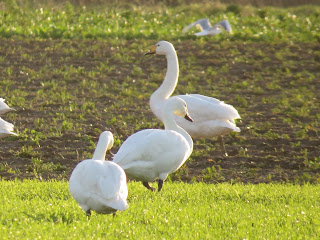 |
| Scarlet Elfcup |
I had enough time for a quick walk around the woods before I had to start my shift this morning at Strumpshaw. A highlight for winter in this part of the reserve are the bright red cups of scarlet elfcup fungi growing on the decaying branches lying on the ground. The air in the woods was also smelling with the pungent scent of a fox. I saw lots of redwings and blackbirds, a couple of goldcrests, a kestrel and heard some bullfinches calling nearby.
 |
| Blackthorn blossom (very early this year) |
 |
| Jay |
 |
| Marsh Tit |
 |
| Blue Tit |
 |
| Blackbird |
 |
| Robin |
 |
| Kestrel |
Mallards, teal, gadwall, shovelers, coots and greylags dominated my time at Reception Hide with a few marsh harriers soaring above the reedbeds behind them. No otters this time, not even a kingfisher. This peaceful scene of wildfowl and harriers was disturbed though, as the sound of guns blasting apart the silence.
 |
| Ducks outside Reception Hide |
 |
| Greylags |
 |
| Mallard |
 |
| Shoveler |
 |
| Marsh Harrier with Woodpigeons |
It is the shooting season and as Strumpshaw is only leased to the RSPB, the landowners are allowed to shoot pheasants on the reserve. This is part of the lease contract. We can keep the land as a nature reserve, but only if they can shoot the gamebirds in the woods for a short time for 3 Wednesdays during January and February. It is ironic that a nature reserve established to protect birds have to allow a few to die in such a manner, but it is the only way we can keep Strumpshaw as it is. This does mean we have to close the reserve for a short while and watch all the birds flee from the gunfire, but at least it doesn't last very long. Amongst the fleeing birds, I notice a strange bird with a long bill fly past like a bat out of hell. It was a woodcock! I didn't see it in great detail, but it was defintely a woodcock.
 |
| Wigeon |
When my shift was over, Dad arrived to pick me up. But we weren't going home, yet. We had a couple of places to go to first. At Buckenham Marshes, we walked down to the river bank and scanned the marshes with my scope for geese. Wigeon were in great numbers on the river behind us and their whistles and growls was our soundtrack as I scanned the hundred or so white-fronted geese. These geese were grazing away in the distance with some Canada geese. I also saw a flock of feral barnacle geese with the odd white individual amongst them.
 |
| Male Wigeon |
 |
| Female Wigeon |
 |
| Wigeon on the river |
 |
| White-fronted Geese |
 |
| Canada Geese |
 |
| Barnacle Geese |

 |
| Bewick's and Whooper Swans |
After Buckenham, Dad took me to Ludham. I have been told that a field next to the small airfield here has been attracting a flock of Bewick's swans. As they were large and white, we easily spot them as we arrived to the area. According to the most recent count, there are a hundred Bewicks grazing on the field with about ten whooper swans. Being larger and longer necked than their smaller cousins, you could pick out the whoopers from the crowd with surprising ease. With both species together, it gave me a chance to check the more detailed differences with my scope, especially with their bills. You could hear the swans honking peacefully to one another as they continued to graze. They did not seem to care about the small aircraft landing and taking off from the runway behind them. In fact, it just made the scene more perfect some how.
 |
| Swans and planes! |
 |
| Whooper Swans |
 |
| Bewick's Swans |
 |
| Whooper (left) and Bewick (right) |















































Great stuff as always, love the Jay photo, one I've never managed to even get close to let alone photograph (Usually just see them flying over by me).
ReplyDeleteWell, we have changed the feeding area at Strumpshaw recently. We've added stumps which we put peanuts on them and they have attracted jays to them as well as nuthatches and marsh tits. The feeders are close to the path and the birds are use to people there, giving you close views.
Delete